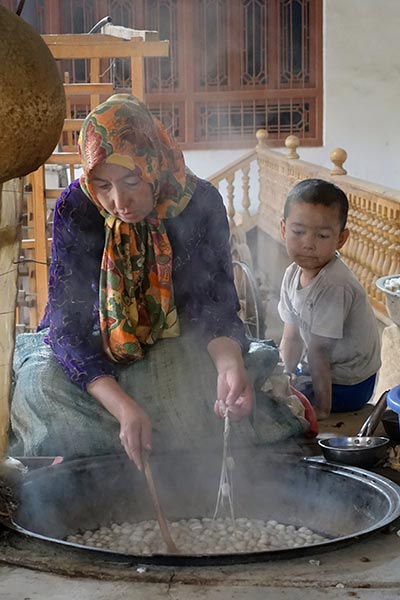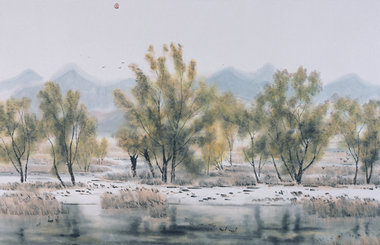Oasis dwellers' knack for spinning yarn
By Cui Jia ( China Daily ) Updated: 2015-08-29 08:57:58
 |
|
A Uygur woman processes silkworm cocoons, the raw material for weaving, at home. [Wang Zhuangfei / China Daily] |
However, the inhabitants are able to cream off extra income by making etles. While the masters make them by hand, most villagers use electric looms.
A bolt of hand-made etles costs 300 yuan ($47), more expensive than those made by machines, says Tajilisa Metson, 21, who has been learning how to make etles for five years.
"More and more people are willing to pay a higher price for hand-made ones because they see them as works of art."
All of her family make etles, she says.
"It's a family tradition, and it's as though we are born to do it."
The small factory in which Ausman works belongs to Jiya Beauty Company, the biggest etles company in Hotan, whose annual turnover is about 5 million yuan ($780,000), says Rozmemet Metudi, the manager.
"More than 90 percent of what we make is sold outside Xinjiang, and some is exported overseas. It's most popular in Uzbekistan, our neighbor."
On Aug 24, the company says, it received 500,000 yuan in government funding to be used to give the traditional designs a modern twist so etles can be promoted on the world stage and bring more income to the villagers, who will also receive training so they can become creative designers too.
Some Chinese fashion designers have incorporated etles elements into their works that they have shown around the world. Etles patterns have also been printed on mugs, cushions and even running shoes.
Amar Ali, 61, an etles master in Jiya, has just returned from Shanghai after promoting the craft there.
"People in Shanghai people loved it," says Amar, who has been in the trade for 45 years.
"They were fascinated about how the etles is made. I really wish I had been able to take my wooden loom with me. Etles is very old, but with modern designs it can be made to appeal to the young and be very popular with modern designs.
"We Jiyans plan to keep it alive forever by sticking to tradition but also exploring the new."
Plans are afoot to open an online etles shop, he says, and he has suggested that it include a video showing the operations of an etles factory.
"I'm confident that with our beautiful etles no one will be able to resist."
Mao Weihua and Yang Wanli contributed to the story.
|
|
|
|
|
|
|
|

























 Raymond Zhou:
Raymond Zhou: Pauline D Loh:
Pauline D Loh: Hot Pot
Hot Pot Eco China
Eco China China Dream
China Dream China Face
China Face






